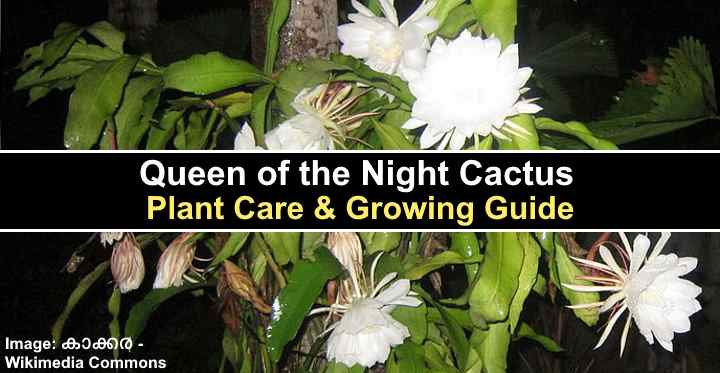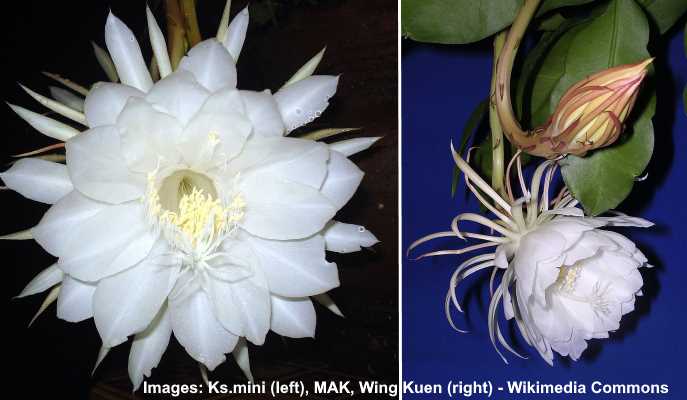Queen of the Night Cactus (Epiphyllum Oxypetalum): Plant Care and Growing Guide

Queen of the night is a flowering cactus with sprawling waxy stems that can grow up to 20 ft. (6 m) long and produces stunning large white showy flowers one night in the year. So, although queen of the night cactus produces flowers, it rarely blooms. When the orchid cactus produces flowers, they only emerge at night and wilt before the morning. The night-blooming characteristic and its stunning flowers make this plant popular for tropical gardens or as a houseplant.
The queen of the night flowering cactus can be tricky to grow and bloom. This article is a guide to caring for this beautiful orchid cactus to increase the chance of blooming one time in the year.
How to Plant Queen of the Night Cactus
Plant queen of the night cactus in well-drained soil that is slightly acidic and retains moisture. To increase the chances of blooming, grow the orchid cactus in bright, indirect light and ensure the temperature is at least 64°F (18°C). In winter, drop the temperature to 60°F (16°C) for eight weeks.
Outdoors, plant queen of the night cactus in the ground where there is dappled sunlight. The orchid cactus will thrive in USDA zones 10 to 12. Keep the ground moist, especially during hot summer days when there’s little rainfall.
About the Queen of the Night Plant (Epiphyllum oxypetalum) – Night Blooming Cereus

Queen of the night (Epiphyllum oxypetalum) is classified as an orchid cactus
The queen of the night (Epiphyllum oxypetalum) is a climbing perennial orchid cactus species native to tropical regions of the world. Outdoors, the queen of the night is found in Southern Mexico, South America, and many parts of Asia. The beautiful cactus is often grown as a houseplant indoors.
The botanical name for queen of the night indicates it’s an epiphytic plant. This means that the thick succulent leaves derive nutrients and moisture from the air and surrounding environment.
The queen of the night is classified as an orchid cactus. The plant stores moisture in its flattened, fleshy, succulent leaves, like all species of cacti. The beautiful large, fragrant white flower gives this plant its name of orchid cactus as the flower has all the beauty of orchid flowers.
Other common names for queen of the night plant include princess of the night, Dutchman’s pipe cactus, night-blooming cereus, and lady of the night.
What is Cereus?
Cereus is a genus in the cactus family that includes several cactus species, many of which flower at night. Although the queen of the night plant doesn’t belong to the genus Cereus, because it is a night-blooming cactus, it is also called a night-blooming cereus. Epiphyllum oxypetalum also shares other growth habits with species of cereus cacti, such as being an epiphytic cactus.
Queen of the Night Cactus Flower (Cereus Flower)

Close up images of queen of the night flower
The stunning queen of the night cactus flower is a showy white flower up to 12” (30 cm) long and 8” (20 cm) wide. The cup-shaped nocturnal flower comprises of 20 to 30 ovate, snowy-white petals, with a ray of white petals forming a star-shaped saucer.
Queen of the night cactus flowers emit a powerful sweet-smelling, floral scent when they bloom one night in the year. The scent is so potent that it can fill a room. It is said that the scent of queen of the night plant flowers growing outdoors can be detected a quarter of a mile away (400 m).
How to make Queen of the Night bloom
Queen of the night cactus flowers need specific conditions to bloom.
Growing indoors, the nocturnal cactus orchid needs bright, indirect light to flower. If growing outdoors, then partial shade is necessary. The flowering cactus needs to be in bright indirect light and temperatures between 40°F to 60°F (4.5°C – 15.5°C) to bloom in winter. Additionally, low-nitrogen cactus fertilizer can encourage blooming during summer.
Another tip to encourage the queen of the night orchid to bloom is to keep it in a relatively small pot. Blooming is better if the orchid cactus is slightly rootbound.
Queen of the night cactus flowers usually start blooming at between 8 and 10 pm and take two to three hours to open fully. However, by dawn, the spectacular white flower will close and then wilt. Blooming usually takes place in June and July.
Queen of the Night Cactus Fruit
A pollinated queen of the night cactus produces purplish-red oblong edible fruits 2” (5 cm) long. The red or pink skin surrounds a white fleshy center that contains black seeds. Some people say the cactus fruit tastes like dragon fruit or pitaya.
Queen of the Night Cactus Plant Care
Regular care throughout the year is the best way to ensure your queen of the night plant thrives and blooms regularly. The three essential factors for healthy orchid cactus growth are adequate sunlight, moist well-drained soil, and regular fertilization.
Let’s look in more detail at how to care for a queen of the night orchid.
Queen of the Night Cactus Light Requirements
Queen of the night cactus thrives in bright, indirect sunlight and needs about six hours of bright light daily. If growing the orchid cactus indoors, place it on a south-facing windowsill with protection from the afternoon sun. If planted in the ground, the queen of the night plant should be in dappled shade.
Bright light is crucial for a queen of the night plant to blossom. Throughout the year—including winter—the queen of the night cactus orchid needs plenty of light. The best light is the morning sun. A lack of sunlight will mean that the plant rarely—if ever—blooms.
How to Water Queen of the Night Cactus Plants
It is essential to water the queen of the night cactus regularly to keep the soil moist. In summer, it may be necessary to water the soil every week. In winter, you can water it less. Before watering, check that the top 1” (2.5 cm) of soil is dry.
Unlike desert plants, the orchid cactus is not drought tolerant and doesn’t perform well if the ground is left to dry out. Dry soil conditions can also affect blooming and be one reason this nocturnal bloomer never produces any flowers.
It is also vital to prevent the queen of the night cactus from sitting in damp, soggy soil. Too much moisture in the potting soil can lead to root rot and cause the flat, succulent leaves to be yellow. Waterlogged soil can also cause the queen of the night to die.
Here are some handy care tips if you are growing queen of the night in a container indoors or outdoors:
- Always water the potting soil when the top 1” (2.5 cm) is dry to ensure the root area never dries out.
- Drench the soil until water runs out of the pot’s drainage holes.
- Use filtered tap water or leave a jar of water out overnight to water the cactus. This helps to prevent a buildup of chemicals in the soil.
Related reading: How to water houseplants correctly.
The Best Soil for Growing Queen of the Night Cactus
Queen of the night cactus thrives in well-drained soil that is slightly acidic and holds some moisture. The ideal potting soil for a cactus orchid growing indoors is an equal mix of peat moss, perlite, and orchid bark. Alternatively, you can use a commercial cactus mix amended with perlite.
The goal of creating a suitable growing medium for a queen of the night cactus is for the soil to hold some moisture yet drain freely. Peat moss is ideal for holding in some moisture. The addition of orchid bark and perlite improves drainage and gives the roots room to grow.
Night-blooming orchid cacti are popular in an outdoor rock garden where they thrive in sandy soil. Always ensure that the ground is kept moist, and provide extra watering on hot, dry summer days to encourage nighttime blooming.
Temperature for Queen of the Night Cactus
Tropical plants such as the queen of the night plants thrive in temperatures between 50°F and 90°F (10°C – 32°C). The minimum temperature for cactus orchids is 40°F (4.5°C). During winter, it’s necessary to expose a queen of the night to cooler temperatures. However, any temperature below 35°F (1.7°C) will damage the cactus’ growth.
As an indoor plant, a cactus orchid performs best in average room temperatures 65°F to 75°F (18°C – 24°F). In winter, move the cactus plant to a cooler place where it’s 60°F to 65°F (16°C – 18°C) during the day and 45°F to 55°F (7°C – 13°C) during the night for eight weeks to help the flower buds develop.
Growing in the ground, the queen of the night cactus thrives in USDA zones 10 to 12. So if you have this beautiful cactus in your garden, it’s vital to protect it from the intense afternoon sun during the summer months.
In temperate climates, you can grow a queen of the night cactus outdoors in the summer in pots. The trailing succulent stems and nocturnal flowers look attractive in hanging baskets on a patio, deck, or balcony. Orchid cacti are not cold-hardy, so bring the plant back indoors when the temperature drops below 60°F (16°C).
Humidity Requirements for Queen of the Night Cactus
Queen of the night cactus performs well in average household humidity. As long as the indoor relative humidity is between 40 and 50 percent, the cactus should thrive. To increase humidity, place the cactus orchid on a pebble and water tray if the air is particularly dry.
There are rarely any problems of humidity when growing a queen of the night cactus in the ground.
How to Fertilize Queen of the Night Cactus to Encourage Blooming
A queen of the night cactus flowers better if the plant gets regular fertilization throughout the year. In spring and fall, use a balanced diluted fertilizer with an NPK ratio of 10-10-10. In February, use a low-nitrogen fertilizer with an NPK ratio of 2-10-10 to encourage blooming.
During the queen of the night cactus’ blooming time during summer, hold off applying fertilizer and keep the potting soil moist but not too soggy.
Related reading: The best indoor plant fertilizers.
Pruning Queen of the Night Cactus
It’s rarely necessary to prune the succulent leaves of a queen of the night cactus. The reasons to prune the fleshy stems of an orchid cactus include managing its size or removing yellowing or dying stems. To prune a queen of the night cactus, cut back the stems to the required size using sharp, sterilized tools.
Propagating Queen of the Night Cactus Houseplants
Leaf cuttings are the best way to propagate a queen of the night cactus. The best cuttings for orchid cactus propagation are ones with tiny hair-like roots on the stem margins. However, stems without these roots will still grow but may take longer to propagate.
To propagate a queen of the night cactus, cut an entire healthy leaf from the plant. Then cut the leaf into 6” (15 cm) sections and cut a ‘V’ shape at the bottom part of the leaf cutting. Place the cactus cuttings flat on moist soil and put them in a dark, cool place for a week. This allows the cut ends to callus over.
While the callus is forming, lightly mist the stems every other day to provide some moisture. After the callus has formed, place the cuttings directly in the soil. Ensure that the ‘V’ end goes into the soil 2” (5 cm) deep. Then place the leaves in a bright location where it’s at least 64°F (18°C).
When roots have started to form on your cuttings, you can transfer the individual propagated stems to a separate pot.
How to Repot Queen of the Night Cactus
Queen of the night cactus blooms better when it’s rootbound. So, you won’t need to repot the flowering cactus often. Typically, only repot the cactus orchid if there are obvious signs of poor drainage. Repotting too often can stress the roots and result in poor blooming during summer.
If you decide to repot the queen of the night cactus, water it 24 hours before the process. This helps reduce shock to the roots. Choose a pot that is one or two sizes larger than the current one. And always use a fresh potting mix with plenty of perlite and orchid bark to create a suitable potting medium.
Pests Affecting Queen of the Night Cactus Growth
The main pests to look out for on a queen of the night cactus are spider mites, mealybugs, scale, and whitefly. To get rid of bugs from your orchid cactus, use a DIY neem oil solution. You should also isolate the trailing cactus plant from other houseplants to prevent infecting other plants.
To get rid of pests, mix 2 tsp. neem oil with 1 tsp. liquid Castile soap in a quart (1 l) of water in a spray bottle and mix well. Spray the queen of the night stems with the neem oil solution to kill the bugs. Repeat the pest spray once a week for best results until all signs of pests are gone.
Related reading: Learn how to spot the signs of houseplant pests.
Disease Affecting Queen of the Night Cactus Growth
The primary disease affecting the queen of the night cactus is root rot. Roots start decaying if the succulent is in soggy ground or soil for too long. The best way to avoid rotting roots is to water the orchid cactus only when the soil is partly dry. However, don’t let the soil dry out between watering as this could attract spider mites.
Powdery mildew looks like a white powdery substance on the queen of the night cactus stems. This harmless condition is usually the result of overly humid conditions. Please check out this article to learn how to treat powdery mildew.
Queen of the Night Cactus Care — FAQs
Is Queen of the Night poisonous?
Queen of the night is not classed as a toxic plant. So, growing a cactus orchid as an indoor houseplant or in your garden won’t pose a risk to cats, dogs, or other animals.
Why does Queen of the Night only bloom at night?
It is thought that night-blooming cereus only blooms at nighttime to reduce competition for pollinators. This way, the nocturnal orchid cactus’s sweet scent, and bright white flowers attract moths, allowing the plant to produce more fruit.
How do you know when Queen of the Night will bloom?
It isn’t easy to know on which day a queen of the night will produce its spectacular large white scented flowers that last one night. However, cactus orchids bloom in summer and only at night. So typically, on the one night when flowers appear, you can expect blooming to start after 8 pm, and it will finish by 6 am.
Related articles:
- Orchid Cactus (Epiphyllum Cactus): Care and Growing Guide.
- Care Guide for Growing Moon Cactus
- Pencil Cactus (Firestick Plant): Care and Growing Guide
